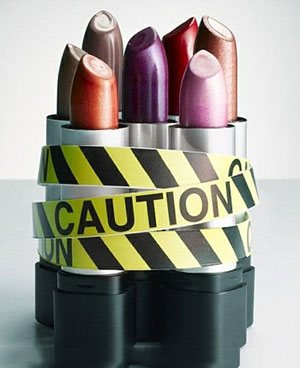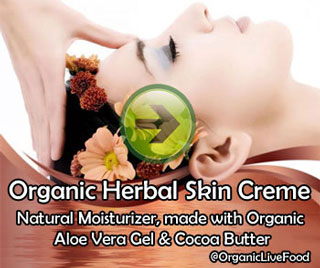We actually are putting by products of crude oil known as Petrolatum on our skin - a known cancer-causing carcinogen according to EU:
Skin is the largest organ in our bodies and it’s impossible to achieve a healthy-looking skin without adopting a healthy life style. However, every year, the cosmetic and Pharmaceutical industries make billions of dollars from moisturizing creams and skin care products that contain tons of harsh chemicals. What is even more shocking is that millions of men and women buy these products for the supposedly miracle creams that promises younger looking skin through skin rejuvenation ingredients.
However, the reality cannot be any further from the truth, since there are tons of toxic ingredients in cosmetics, skin moisturizer creams, and skin care products like white petrolatum, mineral oil, isopropyl myristate, sorbitan monooleate, trietholamine, glycerin and propylene glycol:
Petrolatum and isopropyl myristat: Many skin care products use a combination of petrolatum and isopropyl myristat since they both are cheap and have their own unique properties for the manufacturer. As a matter of fact, petroleum jelly (also called petrolatum) acts as a lubricant for the manufactures’ machinery and it could get absorbed though the skin much better when it’s combined with isopropyl myristat. Petrolatum on its own isn’t easily absorbed through the skin and when it’s combined with isopropyl myristat, it could get absorbed deeply.Research studies have shown that isopropyl myristat could end up clogging the skin pores and many block the supply of oxygen into the skin and result in dead skin deprived from essential nutrients. Also, when isopropyl myristat comes in contact with other substances known as diethanolamine or triethanolamine, it transforms into a cancer-causing chemical known as n-nitrosodiethanolamine. Although the cosmetic industry or regulatory agencies like FDA have not evaluated this compound as carcinogenic, you should be aware of the possible dangers this compound. European Union however has put numerous grades of petrolatum on a list of dangerous substances linked to cancer. Find more about the toxicity of Isopropyl myristate: http://www.bibra-information.co.uk/profile-201.html
According to Environmental Working Group (EWG), (a U.S. non-profit organization that does environmental and safety studies), petrolatum exists in one out of every 14 cosmetic products on the market, including 15% of lipsticks and 40% of baby lotions and oils. Petrolatum is also used as an active ingredient in burn creams.
While the cosmetic industry and petrolatum manufacturers swear by the ability of petrolatum derivatives to moisturize and heal the skin, recent reports and studies have shown that petroleum based products can be hazardous and even toxic to health.
According to besthealthmag.ca, Calgary pharmacist Skip Gibson (who is also the vice-president of sales and marketing for George’s Special Dry Skin Cream, a petroleum jelly-based cream that he helped to create) says that “petrolatum seals off the skin from water and air, and it allows the skin to heal itself”.
Vancouver dermatologist Dr. Richard Thomas also says that “Petroleum jelly is the most effective moisturizer available. The reduction in water loss makes it easier for the epidermis to continue normal function.”
However, according to New York-based dermatologist Dr. Dattner, although petroleum based products are generally regarded as safe, the components that are removed from the oil during the refining process of petroleum jelly are carcinogenic in some cases. “There are probably plenty of petroleum jelly imitators, and one doesn't always know the extent that they're removed." says Dr Denno. He also points out that, since petroleum jelly can be found in "different grades of purity," you don't always know how non-toxic your petroleum jelly-based beauty products really are.
A 2000 study published in the journal of Pediatrics discovered that extremely low birth weight infants who received topical petrolatum ointment for skin care were more likely to develop systemic candidiasis (moist place for fungi to grow):

“Sometimes you want the skin to breathe more,” says Celeste Lutrario,vice-president of research and development for Burt’s Bees, which does not use petrolatum in its products.She says petrolatum is an occlusive barrier, locking in moisture—but it does not allow moisture to be absorbed from the atmosphere.
Another study in 2008 shows that drugs, cosmetics and our food supply is saturated with "food-grade" petroleum and mineral paraffins could be the largest contaminant of our body widely amounting to 1g per person and reaching 10 g in extreme cases: http://seattleorganicrestaurants.com/vegan-whole-food/power-of-oil-companies-mineral-oil-might-be-the-largest-contaminant-of-our-body.php
The fact is that Petrolatum is made from crude oil and the same stuff that goes inside your car engine is used inside cosmetics and skin care products because of its viscosity. Mineral oil which is a derivative of petroleum can block pores in the skin and increase the risk of allergies, skin rashes and even tumors.
So what is Petrolatum doing in burn or your favorite moisturizing creams?
Thanks to the monopoly of the giant oil companies and their power to undermine other renewable sources of energy, petrolatum or petroleum based products (including mineral oil, talc, methylparaben zinc stearate or paraffin) are cheap enough to be used in many products that we use daily like lipstick, eye liner or a burn cream like Silvadene. There are other alternatives to petroleum based products (like oils from natural food sources— olive oil, Tea Tree oil, coconut oil, grapeseed oil or essential oils), but the cosmetic and pharmaceutical industry find them expensive and costly to formulate. Click here to find more about toxic chemicals in burn creams like Silvadene: http://www.seattleorganicrestaurants.com/vegan-whole-food/ingredients-in-burn-creams-silvadene-silver-sulfadiazine.php
When it comes to skin health and beauty, the giant cosmetic and skin care corporations are making billions of dollars off of cheap petroleum-based products and known carcinogens. The repeated and long-term use of these ingredients can result in deterioration of different organs in the body and different side effects.
Be aware of what you put on your skin, since all it takes is only 26 seconds for all the toxic ingredients in your favorite cream to get absorbed through your skin. Be mindful of the ingredients in cosmetics and skin care products and don’t let the giant cosmetic and skin care companies take advantage of you.
Sources:
http://www.besthealthmag.ca/look-great/skin/the-truth-about-petrolatum
http://www.healthy-communications.com/skin_carejudithtovey.htm
http://www.ehow.com/list_6011650_dangers-isopropyl-myristate.html
http://www.huffingtonpost.com/2013/10/21/vaseline-petroleum-jelly_n_4136226.html
http://www.truthinaging.com/ingredients/polyoxyl-40-stearate



